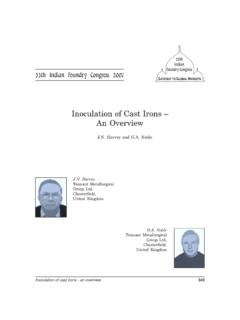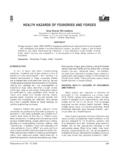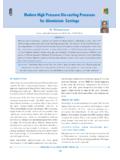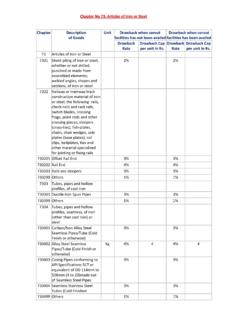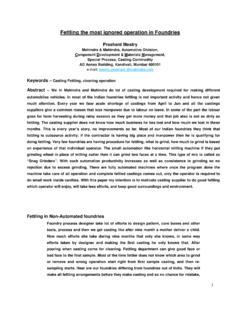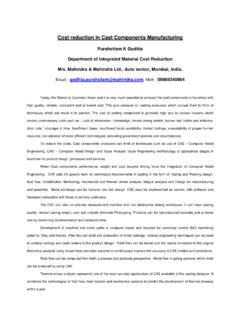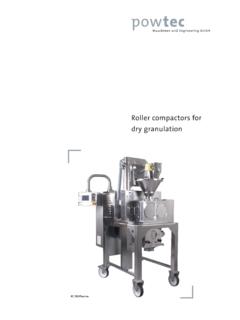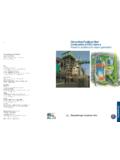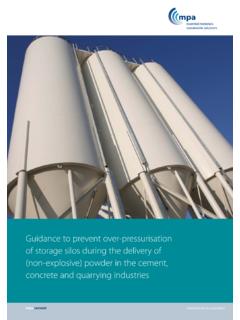Transcription of Modern Sand Reclamation Technologies for …
1 Modern sand Reclamation Technologies for economy , environment friendliness and Energy Efficiency Aniruddha Ghosh GM, The Wesman Engineering Co. Ltd, Kolkata ABSTRACT. Unlike green sand , chemically-bonded sand cannot be used again and again without Reclamation because in this system, the mixed sand gets its strength through chemical reaction, which is irreversible in nature. Each sand particle is coated with this reacted chemical, which behaves like an inert element after it is used once. This inert coating called Dead binder needs to be removed from the used sand because it being brittle in nature gives rise to increased fines in the sand . Dead binder is present in the form of layers adhering to the surface of the sand grains. These layers, if not removed, changes the property of the sand and makes it totally unsuitable for further because proper strength would not be achieved even with higher chemical percentage.
2 sand grain modification is another important aspect of Reclamation . During Reclamation , rubbing take place among sand grains and also against surfaces of the various equipment of the Reclamation system at different stages. As a result, sharp corners of the original sand (which is available from the nature) get rounded causing reduced surface to volume ratio, which ultimately reduce binder demand. This obviously reduces the chance of getting defective casting due to formation of gas. Main methods of sand Reclamation are (1) Mechanical Attrition Reclamation and (2) Thermal sand Reclamation . In Mechanical Attrition Reclamation , rubbing of sand grains against each other takes place by mechanical means like vibration, fluidisation etc. All the binder coatings cannot be removed by this process. As a result, about 10 to 20% fresh sand needs to be added with the sand to keep LOI value within limit.
3 Generally, such sand is reused for the same binder system. Thermal Reclamation is actually a combination of Mechanical Attrition Reclamation and Thermal Reclamation . In this process, mechanically reclaimed sand is heated to a temperature of about 800 C. Heating takes place in a specially-designed furnace where the sand is both fluidised as well as heated. Thus, rubbing of sand against sand takes place here too. Various equipment involved in a Thermal Reclamation System are Lump Reducer, Pneumatic Transporter, Screw Feeder, Combustor with sand Preheater and Air Preheater, Fluidized Bed Cooler and Dust Extraction System. Of these equipments Combustor is the special furnace in which the mechanically-reclaimed sand gets fluidised as well as heated. To utilise the waste heat both incoming sand as well as air is preheated with the help of waste flue gas coming out of the system.
4 From the Screw Feeder mentioned above, mechanically reclaimed sand is fed to the sand Preheater of the Combustor whereby the incoming sand to the furnace gets preheated. Afterwards, the sand is both fluidised as well as heated in the furnace itself. As a result, rubbing of sand against sand as well as burning of dead binders, both are accomplished at the same place. Thermally, reclaimed sand is better than mechanically reclaimed sand as well as fresh and from various aspects as follows: Thermally reclaimed sand undergoes lower thermal expansion causing better mould stability. Thermally reclaimed sand is better than fresh sand because it is more rounded in shape causing lesser binder demand. Irrespective of the binder system in the previous cycle, thermally reclaimed sand can be used with any chemical binder system in the subsequent cycle. As most of the sand is reused, almost no dumping is necessary resulting in safer environment .
5 Conserves natural resources by eliminating requirement of new sand . This is a highly energy-efficient process. TRANSACTIONS OF 61st INDIAN FOUNDRY CONGRESS 2013. |1|. INTRODUCTION fines having more surfaces to volume ratio require more In green sand clay bonded, process the sand is used over resin / chemical to achieve desired level of bond strength. and over again after some treatment of the used The increase of fines in the system sand also contributes demoulded return' sand . The treatment includes sieving, to deterioration of sand properties. These fines, therefore, removal of iron particles, cooling, water and binder are to be removed from the system. Majority of the dead'. addition, mixing etc. binder, however, are present in the form of layers adhering to the surface of the sand grains. If these layers But in case of chemically bonded sand system the mould/.
6 Were not removed, the sand grain would be coated with core strength is developed by chemical reaction or multiple layers of such dead' chemicals in subsequent thermal process. Contrary to the green sand system, cycles. This deposit, being brittle, changes the sand binder in chemically bonded sand is set by irreversible property and would make the sand totally unsuitable for process. It does not remain active' and cannot take part moulding, as proper strength would not be achieved even in the bonding of sand in the next cycle. After the mould/. with higher percentage of chemical. core are set and casting is done, the binder present in the system is totally dead and fresh binder must be added The presence of residual dead' binder in the system is a before the sand can be used in the next cycle. Reuse of determining factor in arriving at the required chemical sand this way, will result in accumulation of dead' binder percentage in the next cycle.
7 The amount of this dead'. in the system making the sand totally unusable. organic binder, usually determined by Loss on Ignition . (LOI), is very important in chemically bonded sand The option, adopted by some, is to discard and dispose system. If the LOI changes in every cycle then percentage the used sand altogether after and start with new sand in of chemicals to be added would also change in every cycle. every cycle. This is not a feasible proposition on economic This situation cannot be accepted as a good operating and environmental consideration. The availability of practice. In practical situation, it is not possible to dumping ground for used chemically bonded sand is determine the required chemical percentage and add the becoming difficult day by day. Cost of dumping is also same accordingly to every cycle. Therefore, every attempt increasing exorbitantly.
8 In addition to non-availability of is to be made to keep the LOI figure more or less constant dumping ground and high dumping cost, the making the system stable'. Stability' means to attain the environmental problem is of critical concern. The dumped LOI figure of the reclaimed sand at the end of the cycle sand , being toxic, would pollute the atmospheric air as equal to the LOI figure of the sand before addition of well as the ground water having long lasting effect on binder in the beginning of the cycle. To attain this environment and plants. The Government authority is condition, it often becomes necessary to add certain becoming stricter on these issues. amount of new sand in the system. The percentage of new On the other hand, availability of new sand is becoming sand required to be added to reclaimed sand generally a problem these days. Local authorities are imposing varies from 10 to 20%.
9 Restriction in mining / extraction of sand altogether. sand Grain Modification: It is another important Therefore supply of new sand to foundries shall be very aspect in considering Reclamation . During Reclamation , little or it may even stop altogether. Therefore they will due to grain-against-grain rubbing/abrading as well as be compelled to survive on sand obtained by reclaiming grain rubbing against rubbing surfaces of various used /de-moulded sand . In addition to above Reclamation equipment at various stages of Reclamation compulsion, there are other good technical reasons for the sand grains get altered. The sharp corners get Reclamation of chemically bonded sand for re-use. rounded, converting the sand grains from angular to sub- TECHNICAL REASONS FOR Reclamation angular to rounded. This improves the desirable property Removal of Dead Binder: The dead binder present in of sand to a great extent.
10 The surface to volume ratio gets the used sand increases the fines' in the system sand . The reduced resulting in reduced binder demand. Due to this TRANSACTIONS OF 61st INDIAN FOUNDRY CONGRESS 2013. |2|. positive effect of Reclamation , the new sand , instead of in the bed. The binder in the sand is totally burnt and hot adding to the system directly, is generally added to the reclaimed sand is obtained at the outlet of the Combustor. lump breaking stage of the Reclamation process so that However, in the Thermal Reclaimer, the sand grains grains are, to some extent, get modified before mixing obtained after breaking the lumps are pre-heated in a heat and moulding. exchanger and fed into the Combustor at a pre- HOW Reclamation IS DONE determined rate. Here it is fluidised by precisely- sand Reclamation can be termed as the process of controlled preheated air.
